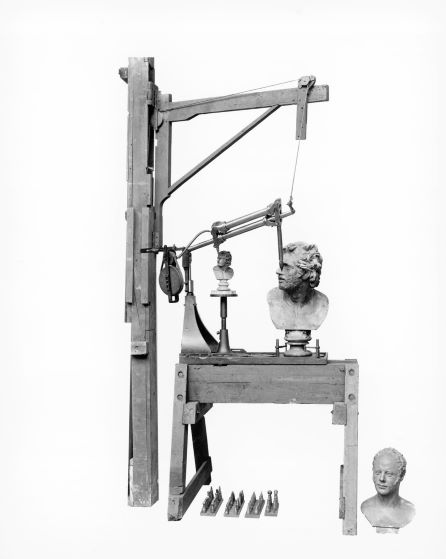Skulpturmaschinen. Wettstreit der Reproduktionstechniken 1770-1880
Machines for Reproducing Sculpture. Competition of Reproduction Techniques 1770-1880

Benjamin Cheverton, Machine for reproducing sculpture, 1826 Science Museum Group Collection, London.
© The Board of Trustees of the Science Museum
The DFG-Project (AL 1777/2-1) takes up the late 18th- and 19th-century technologies for reproduction in the arts with a focus on sculptural objects and materiality. By examining machines developed at the height of early industrialization in Britain, France, and – to some extent – in the USA, the research assesses how the increased mechanization and automation affected the traditional craft working methods of sculptors and engravers. The case of Benjamin Cheverton (1794–1876) shows that artists worked closely together with manufacturers, scientists, and engineers to build machines that made it easier to duplicate and scale-down the size of busts or three-dimensional works of art with high precision: Machine-made small sculptures, coins, reliefs, and busts in different materials became increasingly important regarding seriality, reproduction and the capacity of mass-production in terms of their advantages and usefulness upon art. Bringing together the art object from both the fine and the mechanical arts, aspects of collecting, exhibiting, and displaying ‘replicas’ raise new questions in the context of reproduction. Given the diversity of reproductive technologies that were competitively developed in the first decades of the 19th-century, it is further necessary to add contextual depth to different processes and elaborate on the entanglements. Therefore, the study compares the mechanical process and its reductions ranging from pottery manufacturers to materials such as plaster and ivory or electrotypes with other reproduction techniques by addressing questions of the materiality and the ‘practical turn’ on the one hand, and on the other hand – when negotiating early photography – by considering recent photo-historical discourses, like for example the role of photography in British scientific societies. In addition to the artistic and engineering practices in the context of scientific techniques and the production, distribution and reception of technical knowledge, the example of sculpture machines serves to shed more light on both the migration of objects and concepts of technological expertise as well as the interrelation between artists, scientists, engineers, photographers, markets, and institutions. As a consequence, the ontological approach on the materiality of machines and objects (Simondon 1958/2012; Latour 1996) will be contextualized according to the history and sociology of science concerning the artist/engineer and the notion of machines as active agents. Against this background, it is crucial to negotiate machines for reproducing sculpture as a part of the history/histories of reproduction to position them in the interplay of art, science, and technology in the theoretical context of the discourse about art and its materiality.
Bibliography (selection):
Bruno Latour, “Do Scientific Objects have a History? Pasteur and Whitehead in a Bath of Lactic Acid”, in: Common Knowledge, Vol. 5 (1), 1996, pp. 76–91.
Bruno Latour, “On Interobjectivity,” in: Mind, Culture & Activity, 1996, Vol. 3 (4), pp. 228‐245.
Gilbert Simondon, Du mode d'existence des objets techniques, Paris 1958.
Shortbio:
Buket Altinoba, Dr. phil., heads the DFG-Project “Eigene Stelle” Skulpturmaschinen. Competition of Reproduction Techniques 1770-1880 at the Institute of Art History of the Ludwig-Maximilians-University Munich. Previously she was Visiting Professor for “Historische Bildwissenschaft” at the University of Regensburg. She worked as a research assistant at the Institute for Art and Architectural History at the Karlsruhe Institute of Technology (KIT) and participated as a Fellow in the Mathilde Planck Lectureship Program at the State Academy of Fine Arts Stuttgart. Her PhD on the subject of the Istanbul Academy of Art (Dec 2012) was published under the title The Istanbul Academy of Art from its foundation until today. Modern Art, Nation Building and Cultural Transfer in Turkey (Berlin 2016). Between 2008 and 2010 she was a doctoral fellow of the Graduiertenkolleg “Image-Body-Medium. An Anthropological Perspective” at the Staatliche Hochschule für Gestaltung Karlsruhe. She is a member of the DFG network “Entangled Histories of Art and Migration: Forms, Visibilities, Agents” funded by the German Research Society (DFG) (2018-2021); of the working group “Art Production and Art Theory under the Sign of Global Migration” (since 2013); of the DFG Research Group “Research Network for Transcultural Practices in the Arts and Humanities (RNTP)” of the Humboldt University Berlin and Ruprecht-Karls-University Heidelberg (since 2015).
Recent publications: Figuren der Replikation, edited with Maria Männig, kritische berichte issue 3/2020; Engineers as artists and the reproduction of art objects at early World’s Fairs, in: ‚Gesamtkunstwerk World’s Fair‘. Revisioning International Exhibitions. RIHA special issue 2019 (co-edited with A. Karentzos, M. Oesterreich) (forthcoming); Kunst und Technik. Klaus Lankheit und das Weltausstellungsarchiv, in: Kunstgeschichte an Polytechnischen Instituten, Technischen Hochschulen und Technischen Universitäten. Geschichte – Positionen – Perspektiven, Wien 2021.

